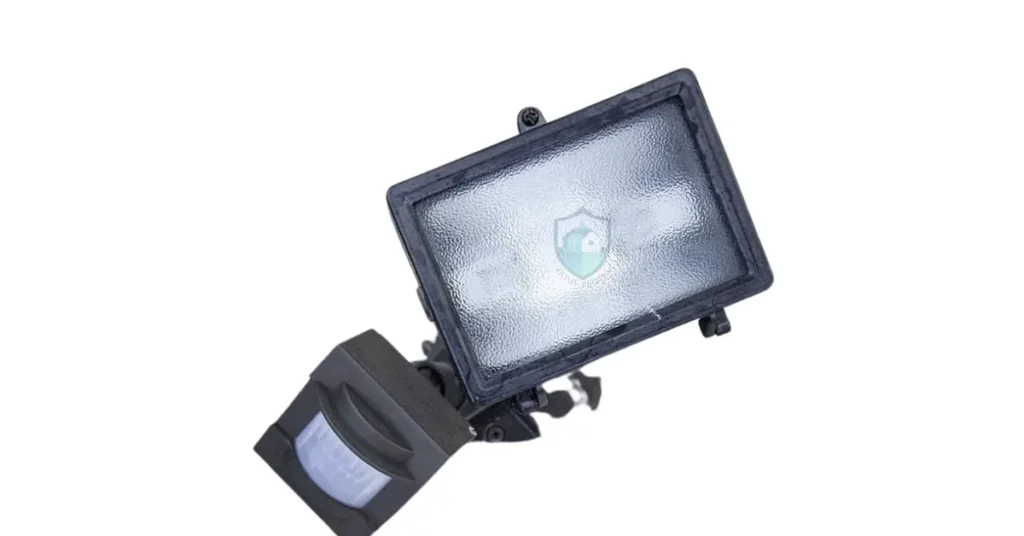Have you ever been jolted awake at night by your outdoor Motion Sensor Light Keeps Turning On for no apparent reason? Yes, a motion sensor light keeps turning on and won’t turn off, there could be several reasons for this issue.
I remember one night being startled out of a sound sleep when the motion light outside my bedroom kept flickering on and off randomly.
This repeated cycle of unexpected bright light made it impossible to fall back asleep. I felt frustrated and perplexed trying to figure out what was causing the false triggers.
Was it a prowler, a wild animal, or just a faulty sensor? After troubleshooting the next day, I discovered a few simple fixes to stop the motion detector light from constantly activating unexpectedly.
In this guide, I’ll explain what causes this issue and how to properly adjust your motion sensor lighting so you can sleep peacefully without random light disruptions.
Let’s dive in!
Steps to Troubleshoot Motion Sensor Light Keeps Turning On
1. Check Sensor Position and Coverage Area
The first step in troubleshooting unexpected motion light activation is carefully inspecting the positioning and coverage area of your motion sensor.
Sensors that are aimed at trees, bushes, flags or other environmental areas prone to movement can pick up incidental motion and trigger the light unnecessarily.
Walk around your property and observe the exact field of view that your motion detector is monitoring. Does it cover a wide area encompassing trees that sway in the wind or bushes where small animals may travel?
Is the sensor angled out toward the street where passing cars headlights could set it off?
Ideally the motion sensor should be focused exclusively on key areas you want to protect like walkways, entry doors, driveways and other zones intended for human motion detection.
Assume that even the slightest motion within the coverage area could activate the light.
If needed, gently grasp the motion sensor housing and pan or tilt it to adjust the aim. Narrow the field of view to remove any peripheral zones not vital for security monitoring.
For example, angle the sensor to avoid aiming at branches that may move slightly in wind.
You can also try adjusting the distance and width of the detection zone if possible on your model. Shortening the reach can help Exclude far off areas prone to environmental motion.
Similarly, narrowing the overall width to focus on a targeted area like a single pathway removes extra coverage that may pick up unwanted motion.
Finally, trim back any obstructing tree branches or vegetation blocking the sensor’s line of sight or causing motion directly in front of the detector. A clear and unobstructed view focused only on necessary areas will help prevent false triggers.
The goal is tuning the motion sensor’s coverage zone to detect substantial human motion in key areas while ignoring incidental environmental movement.
Take the time to meticulously position the detector and refine the aim so it only monitors the appropriate spaces needed to activate the light.
Avoid aiming at bushes, trees or other areas prone to non-human motion. Proper positioning and aiming is crucial to preventing unexpected light turn on and false alarms.
2. Adjust Sensitivity Settings
After positioning your motion sensor, the next troubleshooting step is to adjust the sensitivity settings appropriately. Sensitivity controls how much motion is required to activate the light. Having it set too high increases chances of false triggers.
Locate the sensitivity adjustment dial or switches on your motion detector and familiarize yourself with the settings. There may be simple labels like “High – Medium – Low” or numbered settings like “1 – 10”.
Start by setting the sensitivity to the lowest possible level and test it. This more selective setting will ignore minor environmental motions and only react to major movements like people walking by.
Monitor performance at night to see if unwanted activations have decreased or stopped at the lower sensitivity threshold.
If false triggers still occur at the minimum setting, you may need to recheck positioning or aim to further reduce incidental motion detection. Sensitivity set properly low should avoid most false activations.
Conversely, if the light fails to trigger when desired at the lower sensitivity, gradually increase the setting over a period of days to determine the optimal level.
The goal is finding the right balance where substantial human motion reliably activates the light while ignoring other minor motions like vegetation movement.
Ideally sensitivity will be set low enough that two factors are needed to trigger the light – significant motion intersecting with the coverage zone. This prevents either alone from falsely activating the fixture.
Take the time to methodically test at different sensitivities to understand the impact on your specific installation. The optimal setting will depend on the light’s positioning and intended functionality.
Tuning sensitivity along with positioning and aim are critical to well behaved motion detection. Never assume the factory default is ideal – take ownership of properly adjusting settings for your setup.
Patience and incrementally adjusting sensitivity over days of real world testing will help identify the sweet spot for reliable activation only when desired. Avoid the temptation to have sensitivity set too high, as minor motions will inevitably cause problems.
3. Set Proper Time Delay and Dusk/Dawn Mode
In addition to placement and sensitivity, adjusting your light’s time settings can also help prevent unwanted activations. There are two key options to check – the time delay duration and dusk-to-dawn mode.
Adjust Time Delay Duration
Motion sensing lights have a time delay setting that controls how long the light stays illuminated after being triggered by motion. This delay is designed to keep the light on for a set number of minutes so it doesn’t turn off too quickly after activation.
However, if this duration is too short it can lead to the light cycling on and off excessively. For example, a delay of 5 minutes would turn the light off 5 minutes after being triggered. If motion is still present, the sensor will immediately detect it again and turn the light back on.
This can create a repetitive cycle of the light activating, turning off after 5 minutes, then immediately activating again if sustained motion is occurring. This cycling on and off can be bothersome and even brief time settings can trigger it.
Increase the Time Delay
To prevent frequent cycling, increase the time delay to an appropriate interval. Settings of 10, 20 or 30 minutes or more will keep the light illuminated longer once triggered before shutting off.
This eliminates the quick off cycles if motion remains present and gives time for activity to cease before the light turns off. Try longer settings and observe if cycling stops. The goal is keeping the light on long enough that motion has likely ended when it finally turns off.
Disable Dusk-to-Dawn Mode
Motion activated lights may also have a dusk-to-dawn or “24 hour” mode enabled. This setting keeps the light on continuously from sunset to sunrise regardless of motion detection.
This can be convenient for general visibility but will override motion triggering and keep the light on all night even without motion. If you only want the light active when motion is detected, be sure dusk-to-dawn mode is disabled.
Both appropriate time delays and disabling dusk-to-dawn can prevent unnecessary light activation throughout the night.
Take the time to understand your light’s settings and program them correctly for the desired functionality. Intelligent configuration will prevent irritation and create the right motion detection performance.
4. Clean and Check Motion Sensor Lens
A simple maintenance task that can improve motion sensor performance is periodically cleaning the detector lens. Dirt, debris, spiderwebs, or buildup on the lens can obstruct the sensor’s field of view and cause activation issues.
The motion sensor has a small translucent lens that protects the internal motion detecting components. This clear lens needs to remain clean for the sensor to accurately detect motion across its coverage area.
Over time, dust, pollen, bugs, and other contaminants can accumulate on the surface of the lens. As the lens becomes increasingly dirty, the sensor’s vision becomes more and more obscured.
This distortion and obstruction of the lens can lead to unexpected motion light triggering or failure to activate when desired. The sensor struggles to properly see motion through a significantly blocked lens.
To clean, use a microfiber cloth or soft brush to gently wipe the surface of the motion detector lens. Remove any dirt, dust, spiderwebs, insect debris or other buildup. Be careful not to apply too much pressure or abrasion when cleaning.
For lenses with heavy grime buildup, a mild soap and water solution can help dissolve stuck-on particles. Wipe the lens gently with the soapy microfiber then repeat with a dry cloth to remove any soap residue.
Proper cleaning will restore the motion sensor’s unobstructed view for reliable performance. Check the lens at least a few times per year and clean when necessary.
Also inspect if you notice activation issues or unusual behavior. Aim a bright flashlight at the lens in the dark and watch for any blockages impeding the light passage.
Taking the time to periodically clean and inspect your outdoor motion sensor lenses will help avoid false triggers or missed activations due to obscured vision. Always use gentle cleaning methods to avoid damaging the components. A clean lens equals a properly functioning motion detector.
5. Replace Faulty Motion Detector or Bulb
If you’ve verified positioning, settings, and cleaned the lens, yet the motion light continues to activate unexpectedly, a faulty electrical component could be the culprit. Defective motion detectors, bulbs, or wiring can malfunction and cause trouble.
Aging motion sensors may develop shorts or broken connections internally leading to activation issues. Similarly, the bulb or fixture wiring could have worn out spots intermittently cutting power. These faults can manifest as repeated unreliable cycling or flickering of the light.
To identify if a defective component is the root issue, substitution testing is useful. First, ensure power to the fixture is off/disconnected. Remove the existing bulb and replace it with a new bulb known to be functional.
Restore power and monitor light operation for a period of days. If the cycling or false activations continue with the new bulb, then focus troubleshooting on the motion sensor itself.
However, if swapping the bulb resolves the problem, then the original bulb was likely defective. You can confirm by re-installing the old bulb to observe if issues resume. Eliminating the bulb as the cause suggests examination of the motion sensor is next.
For motion sensor replacement, consult your user manual for proper removal and installation. Most sensors simply twist or unlatch from lamp bases. Again, test operation for a few nights to determine if the new sensor addressed the activation problem.
If both the bulb and sensor test functional when independently swapped, the fixture wiring itself could be at fault. At that point, full fixture replacement may be needed to resolve wiring faults in the lamp assembly.
Taking methodical steps to isolate faulty components will help get motion lighting working properly again. Don’t assume the sensor or bulb is intrinsically bad—do substitution testing to confirm.
6. Consider Smart Lighting Upgrades
If you find yourself continually frustrated by the limitations of conventional motion detectors, upgrading to smart lighting is an option worth considering.
Smart bulbs and motion sensors provide app control, automation, notifications and more advanced functionality through connection to a home automation hub. This unlocks additional convenience and troubleshooting capabilities.
For example, issues with false triggers or unreliability that are difficult to resolve with standard motion lights may be fixable with a smart sensor’s depth of adjustments. Sensitivity, time delays, trigger zones and more can be finely tuned from an app.
You’ll be able to remotely monitor performance and react quickly to any activation issues. Smart motion sensors can also integrate with security cameras to verify human motion versus environmental factors.
bulb replacements like Philips Hue are available that don’t even require fixture changes. The Hue bulbs screw into standard sockets then connect to a wireless bridge enabling app and voice control.
New features like schedules, random vacation modes, motion alerts, and lighting themes are easy with smart bulbs. Control from your phone even when away from home.
The installation cost of smart lighting components continues to decrease while functionality steadily improves. If you’re investing time into troubleshooting and repairs, evaluate whether upgrading to advanced fixtures makes sense.
While not essential, a smart lighting revamp can transform outdoor motion lighting from a source of frustration to a high tech showcase taking full advantage of new technologies.
Frequently Asked Questions About Motion Lights Turning On Unexpectedly
Why Is My Motion Sensor Light Turning On For No Reason?
There are a few common reasons motion lights can activate when no motion is detected:
- Sensor aiming at trees/bushes that trigger from wind or animals
- Sensitivity set too high picking up minor environmental motions
- Time duration set too short causing frequent cycling
- Dusk-to-dawn setting keeping on all night
- Dirty sensor lens obstructing view and causing false triggers
- Faulty motion detector that malfunctions and powers on
- Defective bulb that randomly flickers on and off
Carefully inspect positioning, settings, cleanliness and component condition to identify the specific cause.
How Do I Stop My Motion Sensor From Turning On?
- Adjust sensor positioning/aim away from trees and bushes
- Lower sensitivity setting to avoid minor motion triggers
- Increase time duration to prevent short cycling periods
- Disable dusk-to-dawn setting if not needed
- Clean sensor lens gently with microfiber cloth
- Replace defective bulbs or faulty motion detector
Do Motion Sensor Lights Turn On By Themselves?
Yes, false triggers from environmental factors are common. Wind, trees, bushes, small animals, and bad aim/settings can randomly activate motion lights without human presence detected.
How Do You Reset A Motion Sensor Light?
Resetting typically involves flipping the power switch off/on or removing the bulb briefly. Check user manual for model-specific reset procedures. This may temporarily resolve issues but additional troubleshooting is likely needed to address the root cause.
Can Bugs Activate Motion Sensor Lights?
Yes, crawling insects and flying bugs traversing the sensor’s field of view can trigger motion activation, especially if sensitivity is set high. Ensure lens is clean and sensitivity suitable.
What Can Trigger A Motion Sensor Light?
Wind blowing trees/bushes, falling leaves, small animals, car lights, solar reflections, bad aiming, high sensitivity, faulty components, and dirt on the lens can all cause false motion light triggering when no human is present.
How Do You Troubleshoot A Motion Sensor Light?
- Inspect sensor positioning and aim
- Adjust settings like sensitivity and time duration
- Clean lens with microfiber cloth to remove grime
- Replace defective bulbs and motion sensors
- Consider wiring and fixture issues
- Test with known good replacement parts
- Evaluate upgrading to smart lighting
Do Motion Sensors Go Bad?
Yes, motion detectors can degrade and malfunction over time. Faulty sensors may activate unexpectedly or fail to trigger when motion occurs. Replacing defective sensors generally resolves these issues.
Do Motion Sensors Need To Be Cleaned?
Periodic cleaning is recommended. Dust, dirt, spiderwebs and debris on the sensor lens can obstruct its field of view and cause activation problems. Gently clean the lens a few times per year.
How Many Years Do Motion Sensor Lights Last?
It varies based on weather and use, but most motion detectors work reliably for 5-10 years before needing replacement. Higher end models may last over a decade.
How Can You Tell If A Light Sensor Is Bad?
If the light activates randomly with no motion present, fails to activate with obvious motion, or cycles erratically on/off, a faulty sensor may be the cause. Testing with a replacement sensor will confirm.
How Long Does It Take For A Motion Sensor To Reset?
Reset times vary by model but typically range from 10 seconds to 1-2 minutes. Check user guide for reset procedures and duration.
Can Wind Set Off Motion Sensor Lights?
Yes, wind can falsely trigger motion lights if aimed at trees/bushes that sway. Position away from wind-prone areas and reduce sensitivity to avoid.
Why Do Motion Sensors Give False Detections?
Dirty lenses, bad aim, high sensitivity, electrical faults, wind/rain, insects, IR interference, and hot temperatures can all cause false motion sensor triggering when no motion is present.
Can A Shadow Set Off A Motion Detector?
It’s unlikely but possible depending on conditions. Sensitivity would need to be extremely high and a very distinct shadow would need to cross the coverage area.
Proper troubleshooting and settings adjustments will resolve most cases of unexpected motion detector light activation. Consider replacing faulty components or upgrading to smart lighting if issues persist.
Conclusion
Having your outdoor motion light activate unexpectedly can be a nuisance but is usually fixable. Remember to check positioning, adjust sensitivity lower, clean the lens, verify time settings, and replace any faulty parts.
With proper troubleshooting and configuration, most cases of false triggers can be remedied. Consider upgrading to smart lighting for advanced control and notifications if problems persist.
Taking the time to tune your motion detectors will get them working reliably to properly illuminate when desired and let you rest easy.




